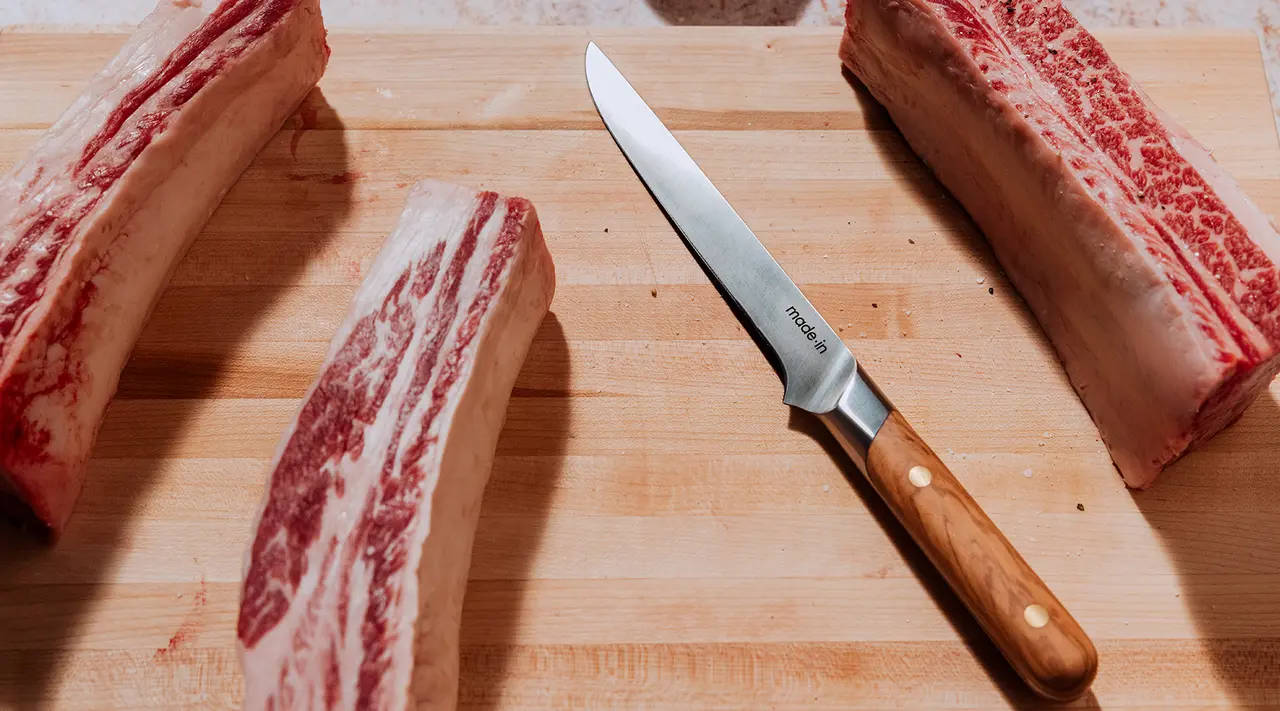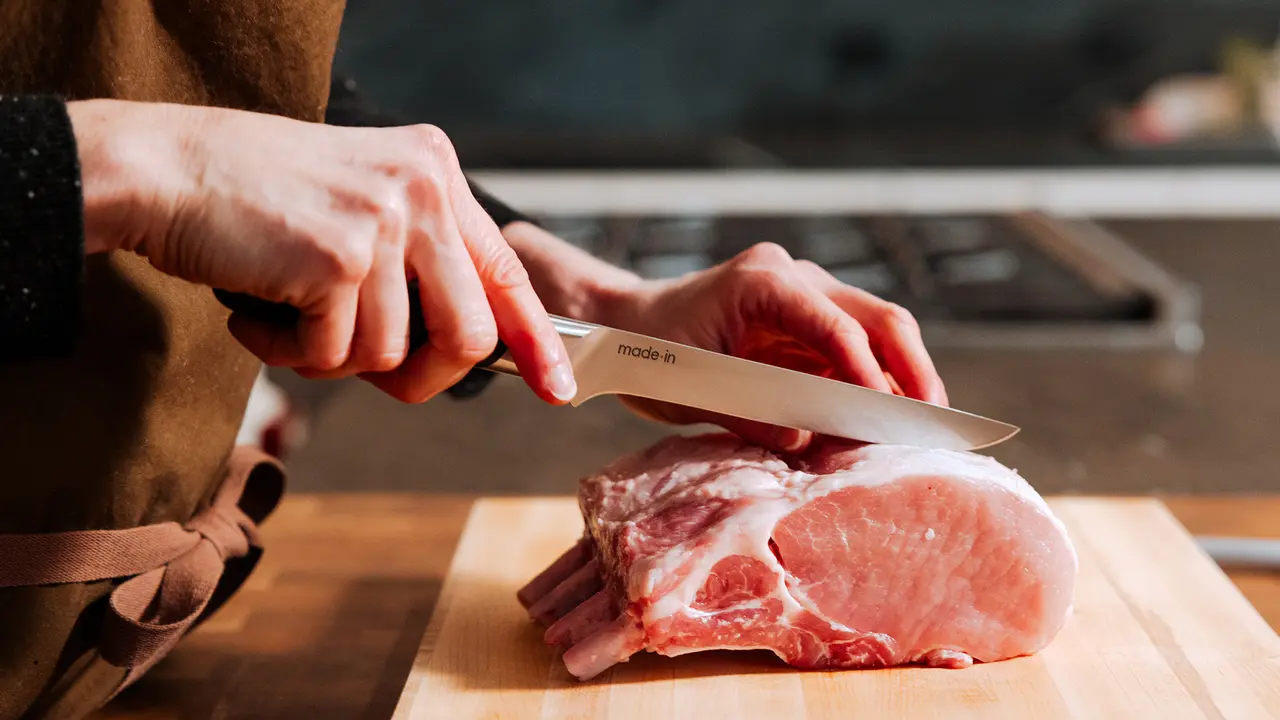If you’ve never used a boning knife before, you may only know it as a long, confusingly thin knife with an unclear purpose—and if you’re unfamiliar with just how useful it can be, it’s time to change that.
While it may look like someone tried to (unsuccessfully) draw a chef knife from memory, the long, skinny blade of a boning knife is unparalleled for breaking down large cuts of meat, poultry, and fish—yes, even more effective than your trusty chef knife.
Here, we’ll talk about why the boning knife looks the way it does, why it’s so good at deboning, and why you should consider adding one to your knife block.
What Is a Boning Knife?

The blade of a boning knife is the main factor that sets it apart from others in your knife block. Thin, semi-flexible, and with an ultra-sharp, tapered tip, the blade is explicitly designed for separating flesh from joints or bones with maximum precision and minimal waste. For example, the blade’s flexibility and long, slender shape makes it easier to maneuver between the spine of a chicken and the breast and separate meat from bone.
Just like with any knife, a boning knife should feel good in your hand. We make the handle of our Boning Knife from POM, a high-quality plastic commonly used in kitchen knives, for a comfortable, grippable handle—an essential characteristic for reducing hand fatigue and giving you better control over the blade.
How Does It Compare to Other Blades?
The boning knife is often compared to a fishing (or fillet) knife which also features a slender, flexible blade and pointed tip. And while one can occasionally be swapped in for the other, there are a couple of key differences between the two.
- A fillet knife will typically be slightly thinner than a boning knife, and even more flexible, allowing you to debone, scale, and portion a whole fish without damaging the delicate flesh.
- While this flexibility makes the fillet knife a choice option for fish, it also makes it slightly less durable than a boning knife, which needs to be tough enough to cut through connective tissue and ligaments.
The shape and flexibility of the boning knife also gives it an advantage over wider blades, such as the carving or chef knife. These options, while excellent at tougher jobs like whole-animal butchery, simply aren’t as nimble as the boning knife. You could use them in a pinch (or if you don’t have any other options available), but you may end up with a bit more waste than if you had used a boning knife.
5 Common Boning Knife Uses

While excellent for deboning, the boning knife is good for far more. Here are a few of our other favorite ways to use it.
1. Deboning Poultry
Chickens and other poultry have a lot of different edible (and delicious) parts to consider when deboning: the thigh, the breast, the wing, the leg, the oyster—the list goes on.
And if you’re breaking a whole one down by yourself (if so, we have a whole guide on how to do that), a boning knife comes in incredibly useful at removing unwanted fat, maneuvering around bones, and separating different parts of meat from the carcass.
2. Trimming Meat
When breaking down a large, bone-in cut—such as a pork shoulder—you need to be able to separate sinew, tendon, and other unwanted bits from the usable flesh (tendons, it should be noted, are perfectly tasty when cooked low and slow for hours, similarly to tripe and other offal).
Our Boning Knife was literally designed for this purpose: not only does the long blade allow you to get the job done with fewer cuts, but it also produces clean, professional-looking chops, steaks, and fillets.
3. Filleting Fish
Even if they’re not quite as bendy as a fillet knife, boning knives still do an excellent job of breaking down whole fish. The blade shape allows you to remove skin and produce clean, evenly-sized fillets using long, smooth strokes, and without leaving perfectly good flesh still attached to bones or skin.
4. Peeling and Sectioning Fruits
Alongside trimming and filleting meat and fish, the boning knife is surprisingly excellent at carving up fruits. Where the wide blade of a chef knife might make clumsy work of breaking down a whole pineapple or hulling fresh strawberries, the blade of a boning knife enables even, elegant slices without too much waste.
Of course, a utility, paring, or Bird’s Beak Knife will do an even better job—though a boning knife is a fine substitute if you don’t have any of these.
5. Precise Vegetable Work
The same factors that make the boning knife excellent for working with fruit also make it a solid option for vegetable prep. The pliant blade and slender tip allow the knife to nimbly separate the thick skin of a butternut squash from the flesh underneath, remove cabbage cores with precision, and even create intricate garnishes like lemon or lime twists.
Ready to Chop?
A boning knife is good for much more than just filling out your knife block. Rather than allowing it to languish, unused and unloved, try swapping it in for a chef knife the next time you need something deboned, filleted, or trimmed.
Our Boning Knife is flexible enough to get between even the smallest bones of a chicken, but durable enough to spatchcock—and features the same French construction and full tang, fully forged build as the other blades in our Knife Collection, to boot.


























